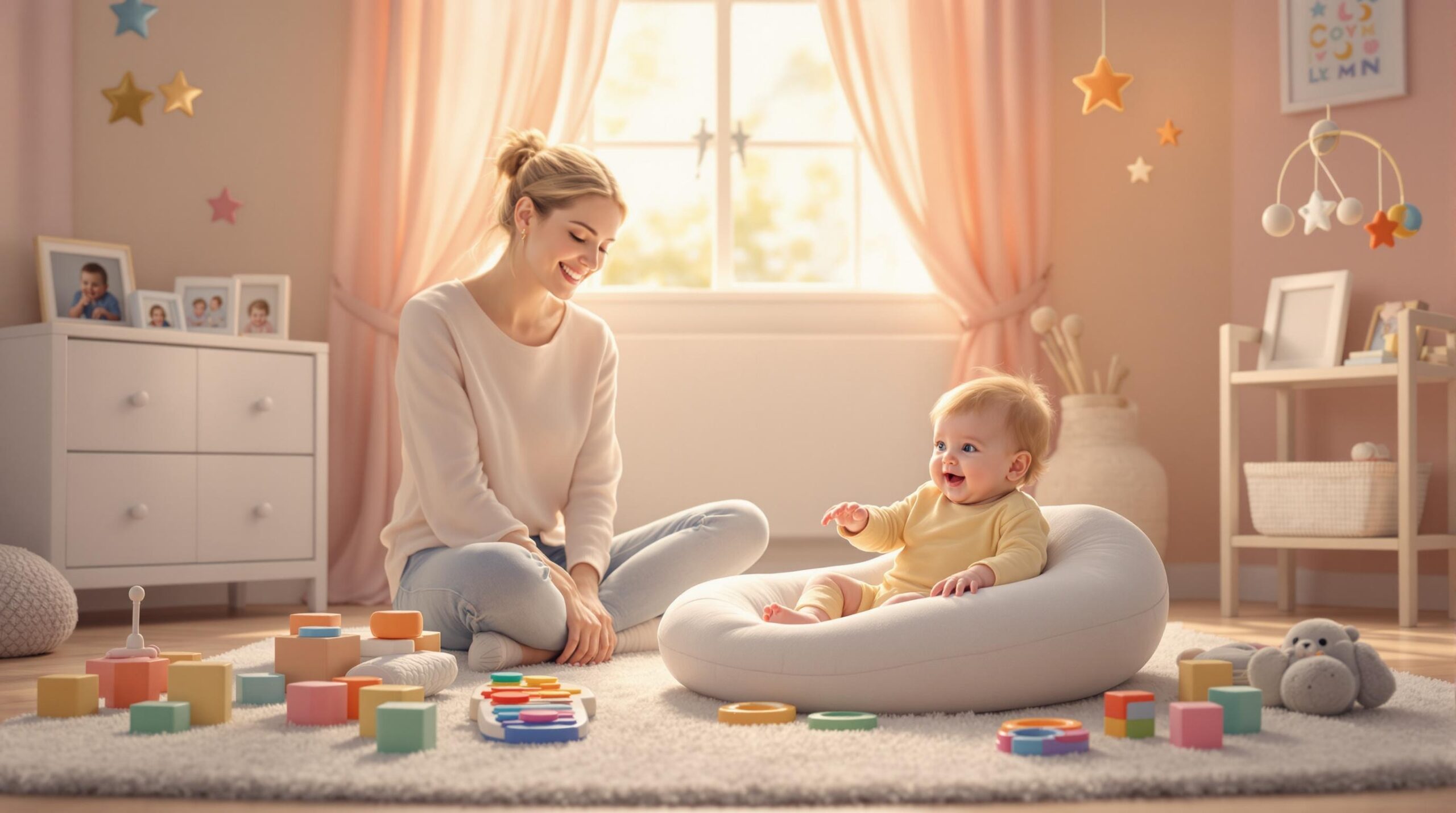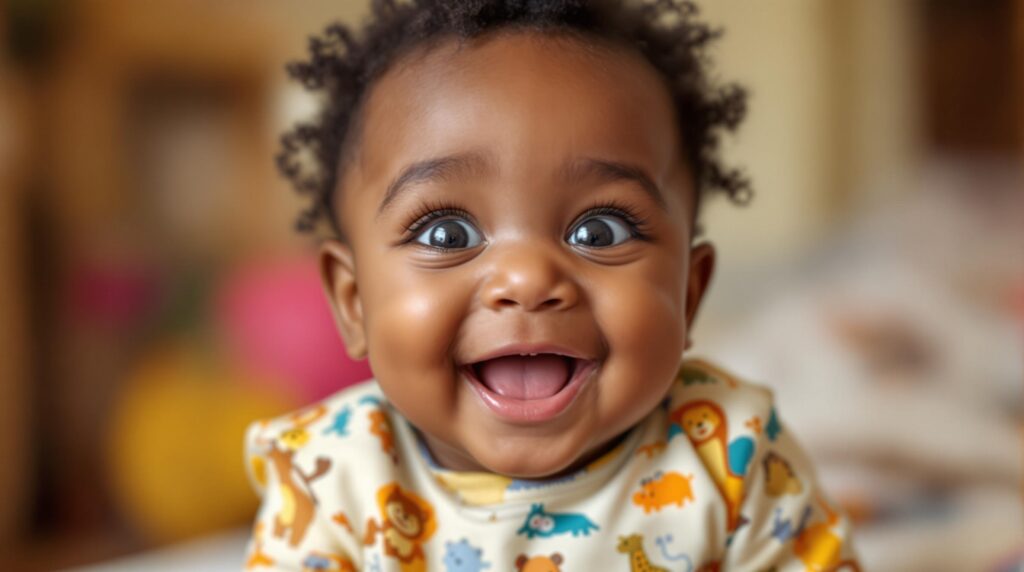Table of Contents
ToggleHere’s the updated article with the new image source:
Watching your baby grow and develop is an incredible journey filled with excitement, wonder, and sometimes a touch of anxiety. As a parent, you’re likely to find yourself marveling at each new skill your little one acquires, from that first social smile to those wobbly first steps. Understanding baby development milestones can help you navigate this amazing first year with confidence and joy.
The Importance of Understanding Baby Development
The first year of a baby’s life is marked by rapid and significant changes. Your little one will transform from a helpless newborn to an active, curious toddler in what seems like the blink of an eye. During this time, babies acquire a vast array of skills across multiple developmental domains, including physical, cognitive, social, and emotional areas.
Keeping track of these milestones isn’t just about checking boxes or comparing your baby to others. It’s about understanding your child’s unique developmental path and being able to identify any potential issues early on. Early identification of developmental delays can lead to timely interventions, which can make a substantial difference in a child’s long-term outcomes.
Remember, though, that every baby is unique and will develop at their own pace. The milestones I’ll discuss are general guidelines, not strict rules. If you have concerns about your baby’s development, always consult with your pediatrician.

The First Three Months: Rapid Growth and Sensory Development
The initial three months of a baby’s life are characterized by rapid physical growth and sensory development. During this period, your baby will begin to develop control over their body, starting with their head.
Physical Development
One of the most noticeable physical developments in the first three months is head control. At birth, your baby’s neck muscles are weak, and they can’t hold their head up. By the end of the third month, most babies can lift their heads 45 degrees while lying on their tummies and hold their heads steady when supported in a sitting position.
Another important physical milestone is the development of grasping reflexes. Newborns have an instinctive grasp reflex, but by three months, they start to open their hands and grasp objects voluntarily. This is a crucial step in milestone development through play, as it allows babies to interact with their environment more actively.
Sensory Development
Sensory development is also in full swing during these first months. Your baby will start recognizing faces, particularly those of their primary caregivers. They’ll begin to focus on objects 8 to 12 inches away and follow moving objects with their eyes.
In terms of hearing, newborns can already recognize their mother’s voice at birth. By three months, babies respond to familiar voices by becoming quiet or smiling. They may also start turning their heads towards the direction of sounds.
Social Development
Perhaps one of the most heart-warming developments in these early months is the emergence of the social smile. Around 6 to 8 weeks, babies begin to smile in response to external stimuli, particularly human faces and voices. This marks the beginning of social interaction and is a crucial step in emotional development.
Cooing is another social milestone that typically emerges around 2 to 3 months. These sweet, vowel-like sounds are your baby’s first attempts at verbal communication and lay the foundation for later language development.
Months 4-6: Increased Mobility and Interaction
As your baby moves into their second trimester of life, you’ll notice significant advancements in their physical abilities, cognitive understanding, and communication skills.
Physical Development
Between 4 and 6 months, many babies master the art of rolling over. This usually starts with rolling from tummy to back, followed by back to tummy. This newfound mobility marks the beginning of your baby’s journey towards independence and exploration.
Sitting also becomes a possibility during this period. While most babies start by sitting with support around 4 months, by 6 months, many can sit unsupported for brief periods. This new perspective of the world opens up exciting possibilities for play and learning.
Cognitive Development
A major cognitive milestone during this period is the beginning of object permanence. This is the understanding that objects continue to exist even when they can’t be seen. You might notice your baby looking for a toy that’s partially hidden or dropping objects repeatedly to watch them fall.
To support this development, try playing simple hide-and-seek games with toys. Cover a toy with a blanket and encourage your baby to find it. This not only helps develop object permanence but also promotes problem-solving skills.
Language Development
Babbling typically begins in earnest during these months. Your baby will start to string together consonant-vowel combinations like “ba-ba” or “ma-ma.” While these sounds don’t have meaning yet, they’re crucial practice for future speech.
Another exciting development is that your baby will likely start responding to their name. They may turn their head or smile when called. This is an important step in social communication and shows that your baby is beginning to understand that certain sounds have meaning.
Months 7-9: Exploration and Independence
The period between 7 and 9 months is often marked by a surge in mobility and a growing sense of independence. Your baby is becoming more aware of their surroundings and eager to explore.
Physical Development
Crawling typically emerges during this period, although some babies may skip crawling altogether and move straight to walking. Crawling is more than just a mode of transportation; it helps develop coordination, strength, and spatial awareness.
Another significant milestone is pulling to stand. This usually happens near the end of this period, around 9 months. Your baby will use furniture to pull themselves up to a standing position, preparing for those first steps.
Cognitive Development
Object permanence, which began to develop earlier, becomes more solidified during these months. Your baby now understands that objects continue to exist even when completely out of sight. This cognitive leap can lead to some challenging behaviors, like increased clinginess when you leave the room.
Social-Emotional Development
Speaking of clinginess, separation anxiety often emerges during this period. Your baby may become upset when you leave them, even for short periods. While this can be challenging, it’s a normal part of development and shows that your baby has formed a strong attachment to you.
Language Development
While not all babies say their first words by 9 months, many start to use specific sounds consistently to refer to specific objects or people. They may say “ba” for ball or “da” for dad. These proto-words are an exciting step towards true language use.
Months 10-12: Walking and Talking
The final months of your baby’s first year are often marked by two major milestones: walking and talking. However, remember that the exact timing can vary greatly from child to child.
Physical Development
Many babies take their first independent steps between 9 and 12 months, with some waiting until 14 or 15 months. Before walking independently, babies usually cruise along furniture and may walk while holding your hands.
To support this development, ensure your home is safe for exploration. Remove or secure any objects that could fall if your baby pulls on them. Encourage walking by placing toys just out of reach or holding your baby’s hands as they practice stepping.
Cognitive Development
Your baby’s problem-solving skills are expanding rapidly. They may figure out how to open containers, fit objects into holes, or use simple tools like a spoon. Encourage this development with age-appropriate puzzles and toys that require manipulation.
Language Development
First words typically appear between 8 and 14 months. By their first birthday, many babies have a vocabulary of 2-3 words, often “mama” and “dada.” They also understand many more words than they can say and may be able to follow simple commands like “Come here” or “Give me the ball.”
Social-Emotional Development
Your baby’s independence continues to grow. They may insist on feeding themselves or choosing their toys. Simple pretend play may also emerge, such as pretending to talk on a toy phone.
The Role of Gestures in Language Development
While we often focus on spoken words as indicators of language development, gestures play a crucial role in early communication and can predict later language skills.
Types of Gestures
Babies typically use three types of gestures:
- Deictic gestures: These include pointing, showing, and giving. They’re used to direct attention to objects or events.
- Conventional gestures: These are culturally-specific gestures like waving “bye-bye” or shaking the head for “no.”
- Representational gestures: These symbolize actions or objects, like flapping arms to represent a bird.
Research has shown that the number, variety, and frequency of gestures a baby uses can predict their later language levels. Babies who use more gestures at 14 months tend to have larger vocabularies at 54 months.
Supporting Gesture Development
To support your baby’s gesture development:
- Use gestures yourself when you speak
- Respond positively when your baby uses gestures
- Play games that involve gestures, like “Pat-a-Cake” or “Peek-a-Boo”
Motor Skills Development: From Head to Toe
Motor skills development follows a predictable pattern, generally progressing from head to toe. This development is crucial for your baby’s ability to interact with their environment and achieve independence.
Gross Motor Skills
Gross motor skills involve the large muscles of the body and include milestones like sitting, crawling, and walking. The progression typically follows this pattern:
- Head control (1-2 months)
- Rolling over (4-6 months)
- Sitting unsupported (6-8 months)
- Crawling (7-10 months)
- Standing (9-12 months)
- Walking (9-18 months)
Fine Motor Skills
Fine motor skills involve the small muscles, particularly in the hands and fingers. These skills develop alongside gross motor skills and are crucial for manipulating objects and eventual self-care activities. Key milestones include:
- Grasping reflexively (birth)
- Bringing hands to mouth (2-3 months)
- Reaching for objects (3-4 months)
- Transferring objects between hands (6-7 months)
- Pincer grasp (thumb and forefinger) (9-12 months)
To support motor skill development, provide plenty of opportunities for activities that boost brain development. This could include tummy time for younger babies, safe spaces for crawling and walking, and age-appropriate toys that encourage grasping and manipulation.
Cognitive Development: Piaget’s Sensorimotor Stage
Jean Piaget’s theory of cognitive development provides a helpful framework for understanding how babies think and learn during their first two years. This period, known as the sensorimotor stage, is characterized by the baby’s interaction with the world through their senses and actions.
Key Concepts
Piaget introduced several important concepts to explain cognitive development:
- Schemas: Mental representations of the world that the child uses to understand and respond to situations
- Assimilation: The process of fitting new information into existing schemas
- Accommodation: The process of changing existing schemas or creating new ones to fit new information
Substages of Sensorimotor Development
Piaget divided the sensorimotor stage into six substages:
- Reflexes (0-1 month): The baby’s actions are based on inborn reflexes
- Primary Circular Reactions (1-4 months): The baby begins to repeat actions that bring pleasure
- Secondary Circular Reactions (4-8 months): The baby becomes more focused on objects in the environment
- Coordination of Secondary Circular Reactions (8-12 months): The baby starts to show intentional behavior
- Tertiary Circular Reactions (12-18 months): The baby begins to experiment with new behaviors
- Early Representational Thought (18-24 months): The baby starts to use symbols and develops object permanence
Understanding these stages can help you provide appropriate experiences and toys to support your baby’s cognitive development at each stage.
Social-Emotional Development: Attachment and Exploration
Social-emotional development in the first year is primarily about forming attachments and learning to balance the need for security with the desire to explore.
Attachment Formation
Attachment is the strong emotional bond that develops between a baby and their primary caregivers. Secure attachment provides a safe base from which the baby can explore the world. Signs of secure attachment include:
- Seeking comfort from the caregiver when distressed
- Preferring the caregiver over strangers
- Greeting the caregiver positively after a separation
Separation and Stranger Anxiety
Around 6-8 months, many babies develop separation anxiety, becoming upset when separated from their primary caregivers. This is a normal part of development and shows that the baby has formed a strong attachment.
Stranger anxiety often emerges around the same time. The baby may become wary of unfamiliar people, even those who are friendly. This anxiety typically peaks around 12-15 months and then gradually decreases.
Balancing Attachment and Exploration
As babies develop, they begin to balance their need for security with their desire to explore. They may venture away from their caregiver to explore, but frequently check back for reassurance. This behavior, known as social referencing, helps the baby learn about their environment while maintaining a sense of safety.
To support healthy social-emotional development:
- Respond consistently and sensitively to your baby’s needs
- Provide a safe environment for exploration
- Offer comfort when your baby is distressed
- Gradually introduce your baby to new people and situations
The Impact of Quality Child Care on Development
For many families, child care is a necessity. The quality of this care can have significant impacts on a child’s development. The NICHD Study of Early Child Care and Youth Development, a comprehensive long-term study, provides valuable insights into this relationship.
Quality of Care Matters
The study found that high-quality child care was associated with better cognitive and language development, regardless of the type of care (center-based, family child care, or individual care provider). Quality care was characterized by:
- Warm, supportive interactions with caregivers
- Age-appropriate cognitive stimulation
- Safe, clean environments
- Small group sizes and low child-to-caregiver ratios
Quantity of Care
The study also found that the quantity of non-parental care mattered. Children who spent more hours in child care showed slightly higher levels of behavior problems, but also had better language skills. However, the effects of quantity were small compared to the effects of quality.
Choosing Quality Care
When selecting child care, consider factors like:
- Caregiver qualifications and training
- Child-to-caregiver ratio
- Physical environment
- Daily activities and schedules
- Communication with parents
Remember, high-quality care can complement the care provided at home, supporting your child’s overall development.
Parental Involvement and Communication
Parental involvement is crucial for supporting your baby’s development across all domains. Your interactions with your baby lay the foundation for their future learning and relationships.
The Importance of Responsive Caregiving
Responsive caregiving involves recognizing and responding promptly and appropriately to your baby’s cues. This type of caregiving supports secure attachment and promotes cognitive, social, and emotional development. To practice responsive caregiving:
- Pay attention to your baby’s signals (cries, facial expressions, body language)
- Respond consistently and promptly
- Adjust your responses based on your baby’s reactions
Fostering Effective Communication
Even before your baby can speak, you can foster effective communication:
- Talk to your baby often, describing what you’re doing or what’s happening around you
- Use facial expressions and gestures along with your words
- Respond to your baby’s attempts at communication, whether they’re coos, babbles, or gestures
- Read to your baby regularly, as this supports early learning and language development
Creating a Stimulating Environment
Your baby’s environment plays a significant role in their development. To create a stimulating environment:
- Provide age-appropriate toys that encourage exploration and problem-solving
- Offer a variety of sensory experiences (different textures, sounds, sights)
- Allow for safe exploration of the environment
- Limit screen time, especially for babies under 18 months
Cultural Influences and Individual Differences
While developmental milestones provide a general guide, it’s important to recognize that culture and individual differences can significantly influence a child’s developmental path.
Cultural Practices and Development
Cultural practices can affect when and how certain milestones are achieved. For example:
- In cultures where babies are carried in slings for much of the day, they may develop neck strength earlier but start crawling later
Sources:
Developmental Milestones
NICHD Study of Early Child Care and Youth Development
Developmental Surveillance
Language Development in Infancy
Gross and Fine Motor Skills Development
Cultural Influences on Child Development
Parent-Child Communication
Child Development and Parental Involvement













This Post Has 4 Comments
Pingback: Signs Your Baby is Teething and How to Soothe Them – GuideForKids
Pingback: Preparing Your Home for Baby: A Comprehensive Checklist – GuideForKids
Pingback: The Role of Parent-Child Bonding in Toddler Social Development – GuideForKids
Pingback: How to Create a Baby Budget That Works – GuideForKids
Comments are closed.